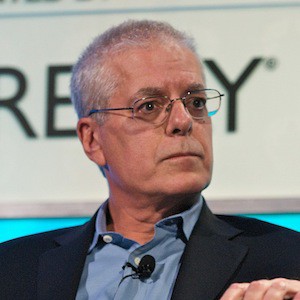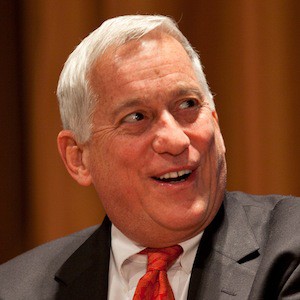Martin Nisenholtz: I am here at the New York Times on February 28th, 2013 with Robert November. I want to start by asking a very simple question. Can you just tell us what your role was at the New York Times insofar as the electronic products are concerned?
Bob November: Yes. In the 1970s, I was the Vice President for News, Education, and Information Services. As such, it was my job to help create and supervise businesses which took the flow of information that was coming into the Times and turn them into profitable enterprises. Included in that was the New York Times Information Bank.
Martin: Can you talk about the birth of that and how that started?
Bob: Yes. I can tell you that…
Martin: I don’t mean to digress. We’ll get back to the…
Bob: Yeah. That, I assume, is the purpose. I need to make clear, because it’s not from this distance as clear, that we’re talking about a time before the Internet when we were building information businesses which were distributed by high speed transmission lines, but they were all dial up and that sort of thing. When the world became computerized, we were looking for ways to, as I say, expand the reach of the New York Times. One exciting and interesting way was how we could make the news and information available in a retrievable mode retrospectively.
Part of the story, but it’s an important part of the story, is that the New York Times was indexed from its very first issue in 1851. One of the things we did in building an information business was to fill in a couple of years which were in the 1860s, which somehow had been lost. We had a continuous hardcopy record of articles in the New York Times.
That was actually a good business because the index and the microfilm editions of the Times were in every major library and in many smaller libraries as well. There was a complete journalistic record of the coverage starting in 1851.
Increasingly, the index under John Rothman’s direction had become, as he would say, indicative as well as indexed. The published index would give you not only a citation but would give you quite a concise summary of the story itself. The index was published every two weeks and was quite voluminous.
In trying to figure out how we could create a retrieval system, the idea was to use the informative abstracts that we were doing every day as a summary of the news in the New York Times. Each of them, of course, had a citation to the full text of the paper.
Unfortunately, this was the days before, because of union restrictions, that the output of the New York Times was in machine readable form. But the input, at the time, was in machine readable form. The news department was using word processing, was editing. So the instructions that went to the composing room were machine readable.
Martin: What year was this, roughly?
Bob: Roughly, I would say we went commercial with the information back in, probably, 1980. What we did was…
Martin: And The Times moved to ATex in the early 70s?
Bob: Yes, but… Probably not so early 70s. But yes, and the process was a continuous one as to the input, the editing and so forth. But there was no final page makeup, for example. There was no machine readable actual pages in the New York Times. We decided to build an enterprise around the abstracts. That was machine readable and computerized. We created that as a database. I should know, but I don’t, probably starting with the 1968 information. We created a technical and a sales staff, so that in 1970 we could offer this to, principally, businesses. Although our index work was with libraries.
Martin: You said 1970?
Bob: I meant ’80. To make it economical, the sales really had to be with businesses and other publications, people for whom the information had an immediate value and saving them the time of going to the index or spending two days looking up something, to be able to do it in a matter of moments was there. We actually built an information bank of the summaries of all the information in The New York Times, with citations. At the same time…
Martin: Did you report to Rothman?
Bob: No, he reported to me. John Rothman.
Martin: So he reported to you.
Bob: Yes. When we decided to go forward with this, we hired an ex IBMer to supervise the information bank, by which we meant the technical and the selling aspect of it. So that the index fed into the abstracts, but the information bank was a separate entity. We had sales people. We had customer service, whom we called trainers. Again, this was the days before Internet, so when a customer came on, our trainer would train them as to how to interface with the information bank. We branched out a little bit. I just glanced at the…
Martin: Let me just say. Was there anything else like this at the time?
Bob: No. Simultaneous with this, the Meade Corporation, which had created Lexis, announced that it would do the same thing for newspapers. But for them to put up the newspapers, they would be willing to make the articles machine readable. Although individual articles were delivered…Our own news service, for example, which went through the AP, our customers would be able to use that as a machine setting. But there weren’t newspapers that were advanced enough that they had page makeup. We decided, at that time, the company was committed to being in the information business. As well as the advertising based journalism business.
Martin: Which is a very prescient thing, at that point in time?
Bob: But it followed, I have to say…Sort of interesting to me. I came to work full time at The Times in 1960. In 1963, there was a disastrous strike by the typographers union. Following that, when Punch became publisher, there was a decision made that we had to create some income stream other than the daily New York Times because we were so vulnerable to labor disruptions. The Times went on an acquisition campaign. That’s when Family Circle television stations…In my area, we branched into the education field. We developed, as I said, from our internal resources, library publishing. We began to treat the news service as a business. It seemed important to us that we have this separate stream.
We deliberately went our own way. We did that, in part, because we felt we could be the journalistic information bank. Our microfilm business, which was part of the division, we not only did The New York Times on microfilm, but we did The Times of London and a couple of other leading newspapers. We were able to persuade them that we would be the most effective.
Martin: In a way, you were the first aggregator?
Bob: We were the first aggregator. Actually, with the information bank, we were the first people to think of doing electronic delivery of news information. But it was not full text. It was hard because the world was not very much attuned to getting electronic information. So we had the training and the technology. We got to the point where this was a break even business. At the same time, almost miraculously, it must have been late ’81, it became possible for us to get the full text. The composing room system had gotten to the point where we could pick up the composing room output. By having one intelligent person with the actual hard copy of the New York Times and the composing feed, we could eliminate from the composing feed, something which had been cut on the composing floor.
We could make sure that what went into a full text information bank was exactly what had been published in the newspaper. That possibility happened in late 1981. It became clear that we should reconfigure the information bank to be full text for The New York Times. Then, frankly, we could go after the same publications that Meade was going after.
But with our special sales. The story I thought would have been very good because Meade was in the legal business and so forth.
Martin: Just one question. It’s a sidebar question, but I need to ask it. There’s another stream that we’re exploring in this ’80, ’81, ’82 timeframe. Principally at Knight Ridder. They had started a video text service called Viewtron. You would have been the natural…
Bob: We did. All along, we tried to follow what was being done. There was a trade association called the Information Industry Association.
Martin: Yeah, I remember. The IIA.
Bob: I was the president of it. The purpose of that was to make sure we were plugged in.
Martin: It still exists, by the way. It’s now called the SIIA. (www.siia.net)
Bob: Because it merged with the Software Association which turned out to be a more viable organization. But also in that were DOW Jones, McGraw Hill and Meade.
Martin: Don Wilson, right?
Bob: Yes. We followed that. It didn’t seem to us, at that moment, that videotex made…Arthur D. Little had a thing where you paid your $20,000 and you became part of a study group on broadband communications, which we also followed. That had applications, obviously, to businesses, but we didn’t see those as being the avenues for The Times.
Martin: So you’re sticking now with this…
Bob: The information bank was our commercial window on the…While keeping our eyes open as to what the other aspects would be. But if we were to go to full text, that required a bigger computer center than we had with the abstracts. In those days, with mainframe computers, there were plenty of time sharing applications. There were companies that had big computers that were not used 24 hours a day that were willing to sell time. The economics of that, I and our division felt, would then make us viable. Without having to make the investment that Meade had to make in its own huge computer center. We were at the point where the abstracts were break even, maybe a little bit profitable, depending how you did the numbers. But it was time to go to full text. That happened to coincide with the change in management at The Times.
Where Walt Mattson became the Chief Operating Officer. He decided that we would not be in the information business. We would be in the newspaper business. Therefore, we would make a deal with Meade. They would then offer the New York Times in full text. Although, in a way I don’t quite understand, we still kept selling the abstracts.
Maybe because we had deals with some other information services to do that. Also get out of the education business, get out of the microfilm business. Get out of all those businesses. That’s the point at which I left The Times and found something else to do. I was sad about that, because I thought it was a great opportunity.
Martin: Do you know why we decided not to pursue it? Do you have any recollection of any rationale, any meetings, anything that might have taken place?
Bob: I can tell you what Mr. Mattson…Walt and I knew each other. We both worked on the western edition of The Times in 1962. We’d been colleagues here. He told me that, as far as he was concerned, we had invested far too much in the things that I was working on, and that henceforth we would concentrate on the newspaper. The amount of capital that we invested in the information business was miniscule. But he was right in that we had had the excitement while he had to do the hard work. That was simultaneous with a huge effort that Punch had initiated with the consulting firm, McKinsey, which had worked in all of our businesses, with cash flow and so forth which was reasonably helpful.
I thought I was trained in economics, so this was a useful thing. But it was my impression that the fad then, in consulting, was to say, “Concentrate on your big business and don’t waste your resources in sidebars.” I thought that was very foolish for two reasons. One is, the geographical reason, with The New York Times.
Another reason that we started decentralizing in 1963 was New York City was not in very good shape and it seemed sensible to be in other cities. Hence, other newspapers. I think that message resonated, certainly with Walter, that we knew the newspaper business. We were so good at selling ads that we should concentrate on this.
As you know, over the years, they gradually sold all the information businesses but the magazines and the specialized things. I think that was part of the McKinsey strategy.
Martin: Were you watching DOW Jones at all, at the time?
Bob: Oh yeah. I mentioned, through the Information Industry Association, the people who manage the information business…My successor, as the president of the Information Association was called Lenty, who was…I can’t say the counterpart because DOW Jones had invested in decentralized publishing much more. Obviously, it had an information service that was very profitable. Yes, we talked a lot. They were in a different business. They would not have considered joining with us, because they rightly felt they had real time information which people would pay for.
But I did follow them. They, as you know, bought Telerate, because they wanted to expand in the information business, which was decimated by Bloomberg, who did a fantastically good job.
Martin: And yet, businesses like Wolters Kluwer, which is a business to business information company based in Holland. It’s a global company. Reed Elsevier are big businesses today.
Bob: They are big businesses. Reed Elsevier prices things very well. No, it was not my idea to get out of the information business. I think it would have been a good thing. What’s interesting about it though is, once Internet came in, it became a publishing business. As opposed just to information business. Crazy enough, with the Information Industry Association, the Software Association, the best, I have to say, that I thought DOW Jones and I and the Times were all placing, that the information would be the valuable thing…
All of a sudden the software, the ability to get the information, became the valuable thing. Which, of course, Microsoft…I don’t have to tell you. The question of how you get rewarded for the information is a very tough one. I must say, I think it’s nice that somebody else has to solve that problem now.
Martin: It is a tough one. There is no doubt. But the reason that we want to go back and look at some of these early efforts is because there were decisions made at certain potions. Interestingly, DOW Jones did decide to pursue this. I don’t know whether it’s mismanagement or simply DNA, whatever it is. But it’s not like DOW Jones has a business the scale of Reed Elsevier or Wolters…They too…
Bob: They saw themselves, incorrectly, in the financial information business.
Martin: But Telerate was a failure.
Bob: Telerate was a failure because — this is just my reading — of Bloomberg. Bloomberg invested in that system and he understood the customers. I have to say that Carl and Bill Dunne, my buddies, were newspaper people.
Bob: DOW Jones was so far ahead of us on the production side. They decentralized publication and they exploited the value of their information amazingly. We didn’t have that kind of information.
Martin: Right. To be fair, they were in national newspaper very early on.
Bob: But it seemed to me that Bloomberg was able to steal the DOW Jones wire and the Telerate business which was built on this very narrow base of bond…The danger of that was that narrow franchise would be somehow undermined which happened and they did a good job. Not directly, but after The Times, I was the publisher of The Bond Buyer, which is a daily newspaper in municipal bonds. And has real time information. It was still kind of a dream, the real time information itself. But there, Bloomberg invested in bond information on a scale that we weren’t ready to do. He’s (Bloomberg) a very savvy investor. Not with the kind of payback he’s gotten on the other kinds of stuff. It was interesting to me that DOW Jones, which made a much bigger bet in this area, was not a success. But I attributed that to Bloomberg.
Martin: You also said something interesting, which is that these were newspaper people. The DNA, it seems to me, matters here. Not just back in the 1970s and 80s, but also right up until the present. One of the things that the newspaper industry and the institutional journalism industry in general, has been unable to do, is really understand the intersection between what they do and the delivery mechanisms, the software, services that underlie it. Maybe part of that is simply DNA. Although you brought this guy from IBM in. He should have understood that.
Bob: Our organization and our sales were effective. I think we would have been significantly profitable selling full text of The Times.
Martin: I think so, too.
Bob: But we were not looking at the business of consumer information. We always started working on niches. We worked with J. Walter Thompson on an advertising news niche. But again, that would be to sell to agencies and to ad Vice Presidents, which we saw as our market. In an amusing way, I had not thought of this before. But Bill Dunn and Walter Mattson are similar kinds of guys. They’re production newspaper guys.
Martin: And your background was journalism? You came up in…
Bob: I started working at The New York Times…
Martin: In advertising?
Bob: After the summer of my junior year at college. This was 1957. I had expected to get a summer job at a bank, which declined to hire me, so I did what is now called networking. I knocked on neighbors’ doors. One of my neighbors was the business manager of The Times, who said, “The Times is starting to move from being a family thing to a company. We should think of a way to get bright, young people.” I have to immodestly say that I had…The timing of this was fortunate for me, because I had been elected Junior Phi Beta at Harvard, which had, of course, given local newspapers this thing. I knocked on this guy’s door. He had just read I was a successful academic. I worked that summer as a newsstand inspector, a summer replacement at a time when The New York Times cost a nickel.
But a newsstand inspector’s job was to adjust the order, so that you had enough but not too many papers. And when the Middle East blew up, which of course it did always, to make sure the Jewish neighborhoods had enough. But also it gave me a chance to understand the whole circulation distribution system, the broader system which was very amazing to me.
By happenstance, a friend of mine was the head of the Harvard newspaper, the Harvard Crimson. The person who had the job of circulation manager was on academic probation, so he asked me if I would do that. For my first half of my senior year at college I was the circulation manager of a 2,000 paid circulation newspaper which was actually a very good experience.
When I came to work at The Times full time, I worked in something called the ad promotion department which is the promotion department that works with the ad to write presentations. I did a presentation on selling automobiles. The point of the presentation was to convince advertisers that The Times was the best publication.
I learned what would be the hot buttons that work with the advertising people. Then, in 1960, Arthur Hayes Sulzberger, who was still publisher, decided that The Times should publish simultaneously in Europe with here. So an international edition was created. It was directed by a couple…Harding Bancroft and [inaudible 07:33] . Who were senior people.
Harding decided that he needed somebody, as he said, to be the amanuensis, which I went to look up. But to be the coordinator. I got the job of coordinating the international edition. It was everything, from making sure we had the light bulbs that fit the linotype machines in Paris to working with the news department to make sure we understood the flow of copy, to make sure we got it…
I did that for six months, I guess. It was a fabulous job. Then The Times decided to do a western edition. I spent several years being kind of generalist. But I ended up as the promotion manager of the western edition. Technically I came in, in the circulation department. But in fact, I was just basically in the business department. It happened when we finished with the western edition, that the person who had been in charge of library publishing got sick.
I was asked to take that over. I discovered that this could be a significant business. The microfilm business was a multi million dollar business. Interestingly enough, in 1940, Kodak had come to The Times and offered to microfilm the back issues, in exchange for the right to sell them. And to provide The Times with the back issues.
The Times agreed to that. Then after the war, a very good company called University Microfilm, in Ann Arbor, which does lots of things, came and said, “Hey guys, that’s crazy. If you work with us, we’ll microfilm it for you. We’re really good at that. And you can sell it yourself. You don’t have to give the rights way.” When I came into this business, Kodak was selling up to 1939 and we were selling and manufacturing the rest.
We persuaded Kodak that this was not the way they should go. We took over that whole thing. Using that as a baseline…
Martin: Kodak gave you the films?
Bob: Kodak manufactured the films.
Martin: But they then turned them over to you?
Bob: Yes. They turned them over. Maybe we owned a set. Maybe part of the deal was that we had a master set.
Martin: But the point is that all throughout this period, there’s a group of people creating this index.
Bob: And way back.
Martin: And way back. That becomes the basis for this computerized service because it’s a database, in essence.
Bob: It’s a database. John Rothman…When Times got its first computer…
Martin: Did you hire John Rothman?
Bob: No. John Rothman was hired in 1946.
Martin: Is he still alive?
Bob: Yes. But he’s long retired. He’s a great indexer. He’s not a great businessman, I have to say, which is why I ended up being his boss, so that we could integrate this into…
Martin: But he had a great vision, if he invented this info bank.
Bob: He had a great vision. He knew about Boolean searches, the idea. When The Times got its first computer, which was a Honeywell, I’d went to programming school, so I could figure out what a computer could do. We were looking for ways to use the power of the computer and the information that we had. But yes, we had a machine readable record of what went on. There were many exciting sales things that we could use to sell things with, that companies would use it to get background on preparing themselves for annual… It was an effective tool. It’s interesting. Because full text searching, obviously, is a much more powerful tool. But it’s also much more of a voluminous tool. Whereas abstracts, informative abstracts we made that distinction are impressive.
Martin: It seems to me that…I’m not quite sure when Moore’s Law came about, when Gordon Moore proclaimed that. I should know, but I don’t.
Bob: I should know that, too.
Martin: But storage, it seems to me, was inevitably going to be more powerful and cheaper, and so the forces were with you.
Bob: The structure of the industry was with us. We didn’t have to be a huge computer center. For the paper we did, but there were plenty of people who would be happy to sell us the time and host us and hook us up. We were very good on the front end. We had a good technical staff. And then the customer interface. It was exciting and I was sad that that Times decided not to do that. But that’s the way it was.
Martin: Thank you. This was a fascinating…Is there anything that you think I’ve missed in terms of this history that is relevant? I, obviously, wasn’t there at the time. If there’s anything I should add, please feel free.
Bob: No, the question that you asked which I asked you but I do want to emphasize that we were not only working on the specific business but trying to keep our eyes open within the industry and within technical development to see if there were other ways to do it. And ultimately, long after I left the Times, the advent of the Internet and retail distribution, as it were, in the publishing side made it different. I am still sad that on the information side this company did not decide to go forward.
Martin: I arrived in 1995 and I can tell you, by then, the information services side, the side that you were in, was well established as an industry. There were big businesses already. We had licenses with these businesses, whether it was Factiva or Reed Elsevier. There were others. There wasn’t even any discussion of whether the Times would ever compete with those.
Bob: That decision was made, I assume by Walter.
Martin: 15 years prior. But it was an interesting opportunity that was potentially missed.
Bob: It was. It was one, I have to say, they made some money in the very short run. Meade was willing to make the investment then.
Martin: It was pretty visionary of a paper company to do. Meade was a paper company in Ohio.
Bob: Which bought the Lexis guys.
Martin: Which bought the Lexis guys, but that…
Bob: I don’t disagree with that.
Martin: That was pretty ballsy of them at that time.
Bob: They did make it. Through the information industry, I was also…I can’t say I was friends with the guy who ran it whose name at the moment escapes me, but with whom I served on the visiting committee libraries at Harvard so I knew these people. I knew the next level pretty well. They did. They did an amazing job, both in software and in investing in the database. And then the Meade Corporation sold it just at the right moment, I think.















